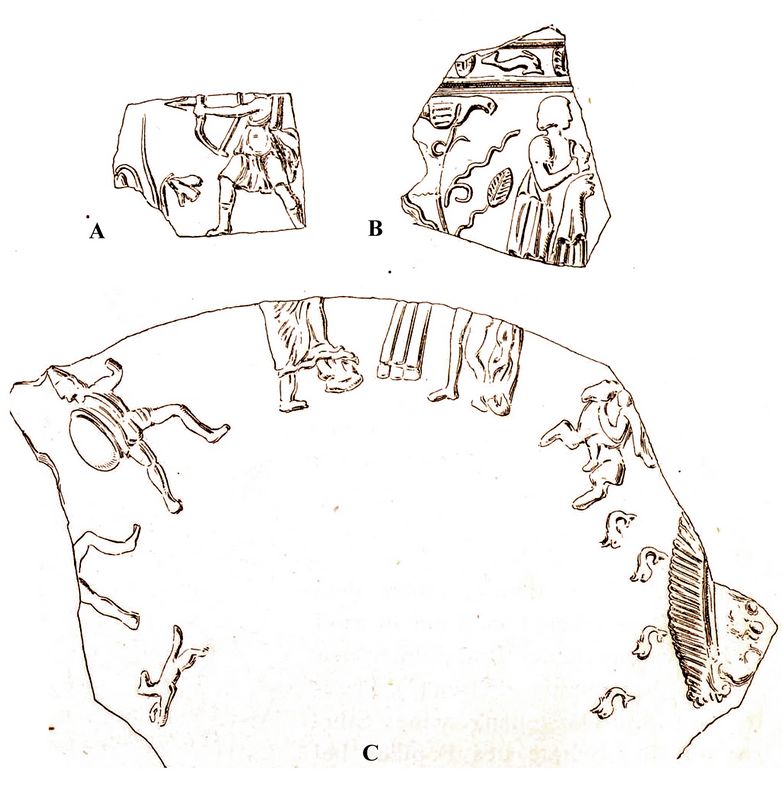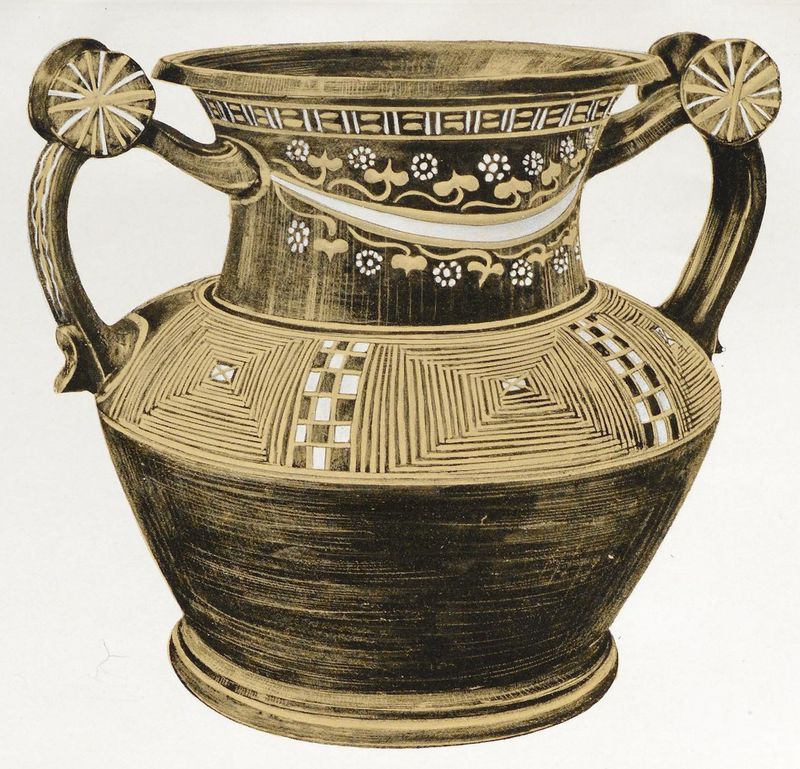|
Vase Finds from Athens [on the western slope of the Acropolis], part 3.
d. Erotic idyllic scenes (p.64), fig.16.
1.
Seated girl from the back; behind him stands a little boy who puts his
hand to his mouth, in front of him another figure whose right arm is
still preserved (fig. 16A).
2. Seated youth holding a naked girl on his lap (fig.16B); cf. the group in Furtwängler Collection Sabouroff I Plate 73.
3. Eros figures with various objects in their hands move to the right in one movement; see Dumont - Chaplain op.cit. Plate XXX.
4. Winged Eros figures holding large bunches of grapes in their hands (fig.16C).
5. Small tripod on column; to the left a small Eros flies.
6. Eros figures riding on dolphins. Sherds from the Acropolis.
Fig.16: body decorations of Megaran pottery, with erotic idyllic scenes.
e. Mythical creatures. (fig.17)
1. Two little men (pygmies?) attack each other with raised arms (fig.17A); between them in height an obscure object (crater on base?).
2. Scylla with three dog heads (fig.17B); in her right hand she probably held an oar (p.65).
3. Triton and sea dragon facing each other, above bird and two Eros figures. Sherds from the Acropolis; see Dumont-Chaplain op cit. Plate XXXIII 5.
f. Mythological Scenes. (fig.17)
1. Youth carries a naked girl to the right (fig.17C). Leucippid robbery ? see Benndorf op.cit. Plate LX 3, b ; 4, b. Dragendorff op. cit. p. 135.
2.
Bearded man carries away a naked boy and looks backwards up at an eagle
that seems to be sitting on his back: Zeus and Ganymede ?
3. Women running, swinging their robes over their heads (fig.17D); between them birds fly.
4.
Legs of a man (fig.17E), behind the right leg is a wheel broken in two
halves; under the legs tripartite rocks (?). Phaeton? cf. the depiction
of his fall on the bowl of Popilius in Hartwig Philologus 1899, 481.
Fig.17: body decorations of Megaran pottery, showing mythical creatures and scenes.
g. Individual figures, sometimes separated by ornaments (p.66) (fig.18).
1. Dionysus, wrapped in a skin, leans on a herm; A panther sits next to him.

3.
Artemis runs to the left, stretching the bow (fig.18A). She wears a short chiton,
the fluttering chlamys around her shoulders, high hunting boots and the
quiver on her back.
4. Woman in a long robe standing quietly (fig. 18B).
5. Lower body of a Hermes depicted in the position of the Praxitelian statue; the chlamys hung from the left arm.
6. Legs of a man in a coat standing in a waiting attitude; cf. Furtwangler Collection Sabouroff I Plate 74,2
7.
Boat under which dolphins swim (fig.18C); (p.67) for the representation of the
ship cf. the bowl from Vulci with four adventures of Odysseus at Rayet
- Collignon op.cit. p. 349 Fig. 130.
8. Woman in a long robe leans on a staff with her left hand and raises a wreath with her right hand.
C. Decoration of the vessel base
1. Rosettes of various shapes, usually surrounded by wreaths of leaves.
2. Medusa head. Sherds from the Acropolis, poorly illustrated by Dumont-Chaplain op. cit. Plate XXXIII 4.
3.
Helmeted head of Athena, high bush on top, wide flaps like wings on the
sides. At the Acropolis - shards, cf. Malmberg antiquities from
southern Russia (Materials for Archeology in Russia, booklet 7) plate I 4.
All
of these sherds must have come from one and the same factory according
to the similarity in clay and varnish. The clay is fairly hard-fired;
the black varnish has a metallic sheen, but is mostly applied unevenly,
so that the edges of some pieces remain unvarnished. The question of
their origin does not need to be discussed here [9]
A
self-contained find provided the starting point for putting together
the following group of vases. The vases and fragments described under
Nos. 1-9 come from a well on the western slope of the Acropolis.
Together with them only fragments of Pnegarian' cups were found in
large (p.68) quantity, but no piece of another type of vase. On the
basis of this find, the other vessels belonging to this area, which
came to light during the excavations on the western slope, could be
separated and the pieces of the same type that I know from museums
could be added.

Plate 3:
Amphora with ornamental band and garland on neck, and checkerboard
patttern on body (No.1). From well on west slope of the Acropolis.
2. Amphora. H. 18.5 cm, redella on the
handles, masks with wide open mouths at the base of the handles, a
tendril with yellow heart petals and white dotted flowers around the
neck. Black and white chessboard pattern on the shoulder alternating
with yellow squares. Yellow crosses with yellow spots on the red
patches [10].
3. Jug with rope handle, height 20 cm (plate 4a). White tendril with yellow volutes and long yellow leaves, between
which are oblong flowers consisting of yellow dots, around the neck. On
the shoulder white and black checkerboard pattern, each alternating
with two yellow squares [11].
Plate 4a: Jug with rope handle and checkboard pattern on body. (No.3), Found in well on west slope of Acropolis.
4. Kantharos, H. 21cm (plate 4b). On each handle in the middle a protruding scale, at the base of
the handle sketchy masks with a wide open mouth. The rim is drawn in to
accommodate a lid. White tendrils around the neck with white punctate
flowers and long pinnate yellow leaves. A tendril with yellow leaves on
the shoulder. The whole lower body is covered with thick, sculpted scales;
a plastic braided band forms the upper end. On the bottom right and
left two large scales protrude on both sides, which are hollowed out
below [12].
Plate 4b:
Kantharos with rim shaped for a lid, with flowers around neck and
sculpted scales on body (No.4), Found in a well on the west slope of
theAcropolis.
5. Jug with spout, most of
which has broken off (fig.20) Height: 15 cm. On the shoulder four large
sculpted leaves, between them smaller ones; the entire shoulder surface
otherwise covered with applique dots. The neck is closed by a screen
with four holes. A corresponding pot is in the National
Museum Inv. 2148 and is shown here because it is better preserved: H.
14 cm, at the top between the plastic leaves one letter of the word
ΛΙΩΝ0S [13]
Fig.20: jug with spout with sculpted leaves on body (No.5)
6 Fragments of a deep bowl decorated with polygons
incised after varnishing. The accompanying figure (fig.20b) shows the
form of a completely preserved specimen in the Heidelberg
Archaeological Institute [14].(No.6)
Fig.20b: Deep bowl with incised polygons (No.6)
Footnotes:
9. For literature see Dragendorff Bonner Jahrbücher 96, 28 ff; about Italian relief cups now Siebourg Rom. Mitt. 1897, 40 ff; see Rizzo, ibid.,
p. 259. Megaric beakers were made wherever suitable clay was available.
The clay molds found there (cf. National Museum Inv. 2361) prove that
Athens was also not lacking in production. In order to determine the
homeland of form and decoration, the most important thing is to answer
the question of how far the clay forms have been exported and where we
have to look for the place of manufacture of these and the metal models.
10. The amphora from Olbia Compte rendu
1896 p. 208 Fig. 594 is similar, only provided with rope handles;
Further developed in form and decoration is an amphora in Bonn, also
from Olbia stamtoende, see Loeschcke Arch. op.cit.
32 ff., who has already assigned the right place in the history of
ceramics to the vases belonging to it. Also included here is the
amphora from Taman, already mentioned by Dragendorff in the Hermitage Compte rendu
1880 p. 14, supplementary plate No. 5, and the amphora illustrated
there, No. 4, whose shape is even closer to the ones discussed above,
but which after the lack of varnish and judging by the bad sound it
probably came from a local Crimean factory.
11. A fragment of a
corresponding jug with checkerboard patterns and squares on the
shoulder, leafy tendrils around the neck from the Amphiareion was shown
to me by de Mot in the Museum of Skala Oropu. An unvarnished jug of
exactly the same shape (h. 17 cm.) has been found in the excavations on
the western slope: fine and common ware go side by side.
12. These
scales may correspond in their original purpose to the lion heads
protruding in the same place from the large silver vase from Nikopol Compte rendu
1864 taf. I — III, p. Mim, 1897, 282 has assumed the same use, and a
lion's head from a terracotta mold from the Chersonnes near Malmberg
op.cit.. Plate III 5.
13.
I owe permission to publish this and the other vases in the National
Museum to the kind cooperation of Idern Ephoros Dr. V Stais.
14.
I owe the reference to the vases of this genus in Heidelberg and the
permission to publish them to the kindness of F. von Duhn and R. Zahn.
[Continue to part 4]
[Return to table of contents]
|
|